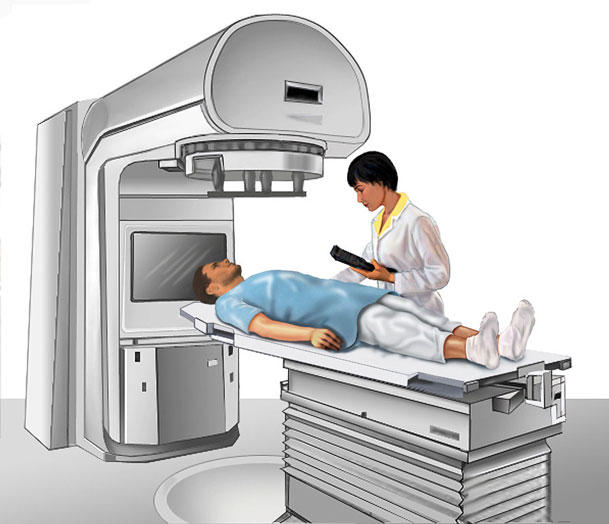
Diagnosed with Cancer? Your two greatest challenges are understanding cancer and understanding possible side effects from chemo and radiation. Knowledge is Power!
Learn about conventional, complementary, and integrative therapies.
Dealing with treatment side effects? Learn about evidence-based therapies to alleviate your symptoms.
Click the orange button to the right to learn more.
- You are here:
- Home »
- Blog »
- side effects ID and prevention »
- Long-term Side Effects of Radiation
Long-term Side Effects of Radiation

“Concern over long-term side effects of radiation therapy is becoming more common, as survival rates improve. Just as there can be long-term side effects of chemotherapy, radiation therapy may result in side effects that may begin and linger far after treatment has been completed.”
Newly diagnosed cancer patients don’t know what they don’t know. While that sentence sounds non-sensical, I use it frequently throughout PeopleBeatingCancer.org in order to explain my thinking (or lack thereof) when I was first diagnosed with cancer.
The key issue discussed in this post is/are possible long-term and late stage side effects of ionizing radiation. What is NOT understood my the newly diagnosed cancer patient is that he/she can feel perfectly normal in the days following their last radiation treatment but then develop devastating long-term or late stage side effects from that ionizing radiation.
What is the difference between “long-term” and “late stage” side effects?
Long-Term Side Effects:
Definition:
- Timeframe: Long-term side effects are adverse effects that develop during cancer treatment and can persist for years after treatment stops.
- Nature: These side effects can be both physical and psychological, affecting various aspects of a person’s health and well-being.
- Examples:
- Chronic fatigue
- Cognitive issues (chemo brain)
- Cardiovascular problems
- CIPN
- Endocrine issues (e.g., hormonal imbalances)
- Xerostomia
- Dysphagia
Management:
- Monitoring: Long-term side effects may require ongoing monitoring and management by healthcare providers, sometimes extending well beyond the active treatment phase.
- Rehabilitation: Rehabilitation services, lifestyle modifications, and supportive care may be recommended to address long-term side effects.
Late-Stage Side Effects:
Definition:
- Timeframe: Late-stage side effects typically refer to adverse effects that emerge years after the completion of cancer treatment.
- Examples:
- Radiation-induced lumbosacral plexopathy (RILP)
- Hemorrhaggic Cystitis (irritable bladder)
- Secondary cancer- Radiation is a known carcinogen, and exposure to high doses can increase the risk of developing cancer. The specific types of cancer that may result from radiation exposure depend on the organs or tissues that are exposed. For example, exposure to radiation in the chest area may increase the risk of developing lung or breast cancer.
- Genetic Effects:
- High doses of radiation can cause damage to the DNA in cells. While the risk of hereditary genetic effects is generally considered to be low, there is some evidence that exposure to high doses of radiation may increase the risk of genetic mutations that can be passed on to future generations.
- Chronic Health Conditions:
- Long-term exposure to radiation may increase the risk of certain chronic health conditions, such as cardiovascular disease. The mechanisms behind these effects are complex and may involve damage to blood vessels and tissues.
- Thyroid Disorders:
- Exposure to radioactive iodine can increase the risk of thyroid disorders, including hypothyroidism or an increased risk of thyroid cancer. This is particularly relevant in the context of nuclear accidents where radioactive iodine may be released into the environment.
- Cataracts:
- High doses of radiation, especially to the eyes, can increase the risk of developing cataracts over time.
- Long-Term Organ Damage:
- Radiation exposure can damage organs and tissues, leading to long-term functional impairment. This is more likely to occur with higher doses of radiation.
Exposure to ionizing radiation can have various long-term effects on health, depending on factors such as the dose, duration of exposure, type of radiation, and individual susceptibility. It’s important to note that most people are exposed to low levels of radiation in their daily lives, and the risks of significant long-term effects are generally associated with high-dose exposures, such as those experienced in certain medical treatments or nuclear accidents. Here are some potential long-term effects of ionizing radiation:
In my experience, oncologists don’t know much about the long-term side effects of what the therapies they prescribe. Unfortunately, the patient is on their own when it comes to radiation’s long-term side effects
Are you about to undergo radiation? Have you undergone radiation and are wondering about the possible side effects? Let me know-
David.PeopleBeatingCancer@gmail.com
Thank you,
David Emerson
- Cancer Survivor
- Cancer Coach
- Director PeopleBeatingCancer
Resveratrol rescues cutaneous radiation-induced DNA damage via a novel AMPK/SIRT7/HMGB1 regulatory axis
“Cutaneous radiation injury (CRI) interrupts the scheduled process of radiotherapy and even compromises the life quality of patients. However, the current clinical options for alleviating CRI are relatively limited. Resveratrol (RSV) has been shown to be a promising protective agent against CRI; yet the mechanisms of RSV enhancing radioresistance were not fully elucidated and limited its clinical application. In this study, we demonstrate RSV promotes cutaneous radioresistance mainly through SIRT7….”
Hyperbaric Treatment of Delayed Radiation Injury
“There will be 1.2 million cases of invasive cancer diagnosed in the United States this year. Half of those patients will receive radiation therapy as part of their treatment program. Serious radiation complications will occur in 5% of patients receiving radiation therapy. This represents about 30,000 cases per year.Often, delayed effects of radiation are diagnosed when an additional insult to the tissue such as surgery or trauma occurs. This activity explains how to properly evaluate radiation induced injury and highlights the role of the interprofessional team in caring for patients with this condition.
Objectives:
-
Describe the pathophysiology of radiation induced tissue injury.
-
Review the presentation of patients with radiation induced tissue injury.
-
Summarize the treatment options for radiation induced tissue injury.
-
Outline the importance of enhancing care coordination among the interprofessional team to ensure proper evaluation and management of radiation induced tissue injury.
Long-Term Side Effects of Radiation Therapy
“Concern over long-term side effects of radiation therapy is becoming more common, as survival rates improve. Just as there can be long-term side effects of chemotherapy, radiation therapy may result in side effects that may begin and linger far after treatment has been completed.
These can include heart problems, lung problems, thyroid problems, secondary cancers, and more, but it’s important to keep in mind that the benefits of these treatments usually far outweigh any risks. Many people will not experience any of these late effects.1
Radiation therapy works by damaging DNA in cells. This damage isn’t isolated to cancer cells, though; normal cells can be damaged as well. While radiation therapy has improved significantly such that less damage occurs to healthy cells than in the past, some healthy tissues are inevitably exposed.2
Several variables can increase or decrease your risk of developing long-term side effects of radiotherapy. Some of these are:2
- Your age at the time of radiation
- The dose of radiation you receive
- The number of treatment sessions
- The type of cancer treated
- The area of the body that receives radiation
- Other cancer treatments, such as chemotherapy
- Other health conditions, such as heart disease or diabetes…
Not everyone will have long-term side effects after radiation treatment. Many people will only experience some redness of their skin and fatigue at the time of treatment.4
Even so, it’s important to be aware of possible risks, such as heart disease, so you can be an empowered patient.
Hypothyroidism
Hypothyroidism is one of the more common late effects of radiation therapy when radiation treatment involves the neck, head, and chest.5
Immunotherapy drugs also increase the risk of hypothyroidism, so that those who have received both of these treatments should be extra aware of the possibility.6
Radiation Fibrosis Syndrome
Radiation fibrosis can be thought of simplistically as the loss of elasticity in tissues after radiation, due to permanent scarring.
Many of the side effects below are caused by this fibrosis, which can occur in nearly any region of the body.7
Pulmonary Fibrosis
Lung fibrosis is a permanent scarring of the lungs which can result from untreated radiation pneumonitis.
Radiation pneumonitis is an inflammation of the lungs which occurs between one and six months after completing radiation therapy to the chest and happens in roughly a fourth of people treated with radiation for lung cancer.
Since the symptoms can mimic symptoms of cancer or pneumonia, it’s important to talk to your doctor about any new respiratory symptoms.8
Heart Disease
Heart disease is a very important and not uncommon long-term side effect of radiation therapy.
For example, in patients with Hodgkin’s disease who receive radiation therapy (not as common now), the leading cause of death is cardiovascular disease, not cancer.9
Those at risk include people who have radiation to the chest, including radiation following a mastectomy for left-sided breast cancer.
Radiation can affect the heart in several different ways causing:9
- Coronary artery disease: Coronary artery disease caused by atherosclerosis can be a side effect of radiation.
- Valvular heart disease: Radiation may result in damage to the heart valves.
- Pericardial conditions: Conditions s such as pericardial effusions (a build-up of fluid between the tissue layers lining the heart) and constrictive pericarditis may occur.
- Cardiomyopathy: This weakening of the heart muscle may occur, especially when combined with some chemotherapy drugs such as Adriamycin (doxorubicin).
- Abnormal heart rhythms: These are called arrhythmias.
Symptoms of heart disease may not appear for years or decades following the completion of radiation treatment, so it’s important to let your doctor know if you have any chest pain or other symptoms suggestive of heart disease.9
Newer techniques such as respiratory gating (controlled breathing designed to minimize the exposure of the heart to radiation) are becoming available and may lower the risk of heart-related complications.10..”


